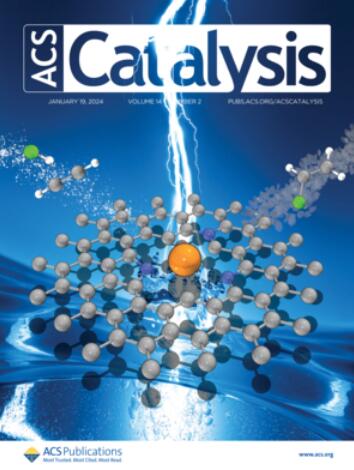基于Re单原子的受挫路易斯对催化剂用于高效太阳能驱动的二氧化碳转化
IF 13.1
1区 化学
Q1 CHEMISTRY, PHYSICAL
引用次数: 0
摘要
由于小分子受挫刘易斯对(FLP)位点的高效活化能力,基于FLP的材料的开发是利用太阳能将二氧化碳转化为增值化学品的一条迷人途径。本文将铼(Re)单原子引入石墨氮化碳(Re1/gCN)骨架中,构建了独特的N···Re1 FLP位点,其中Re单原子和相邻的N原子分别作为酸性和碱性位点。N···Re1 FLP位点可以通过剧烈的d-p轨道相互作用与CO2分子相互作用形成Re-O-C-N结构(酸位-碱位-酸位-碱位),从而诱导不寻常的推推电子效应,有效地破坏C = O键,用于CO2活化和转化。结果表明,在不添加任何牺牲剂的情况下,Re1/gCN光催化CO2-to-CO生成速率高达123.4 μmol g-1 h-1 (CO选择性为95.6%),超过了大多数现有催化剂在类似测试条件下的性能。本文章由计算机程序翻译,如有差异,请以英文原文为准。

Frustrated Lewis-Pair Catalyst Based on Re Single Atoms for Efficient Solar-Driven CO2 Conversion
Owing to the highly efficient activation ability of frustrated Lewis-pair (FLP) sites for small molecules, the development of FLP-based materials is a fascinating route to convert CO2 to value-added chemicals using solar energy. Herein, rhenium (Re) single atoms are introduced into the frame of graphitic carbon nitride (Re1/gCN) to construct unique N···Re1 FLP sites, where Re single atoms and neighboring N atoms serve as acidic and basic sites, respectively. The N···Re1 FLP sites can interact with CO2 molecules to form a Re–O–C-N structure (acid site–basic site–acid site–basic site) via the dramatic d–p orbital interactions, thus inducing an unusual push–push electronic effect to effectively break the C═O bond for CO2 activation and conversion. As a result, Re1/gCN achieves a high photocatalytic CO2-to-CO generation rate of 123.4 μmol g–1 h–1 (a CO selectivity of 95.6%) without any sacrificial agents, exceeding the majority of state-of-the-art catalysts under similar test conditions.
求助全文
通过发布文献求助,成功后即可免费获取论文全文。
去求助
来源期刊

ACS Catalysis
CHEMISTRY, PHYSICAL-
CiteScore
20.80
自引率
6.20%
发文量
1253
审稿时长
1.5 months
期刊介绍:
ACS Catalysis is an esteemed journal that publishes original research in the fields of heterogeneous catalysis, molecular catalysis, and biocatalysis. It offers broad coverage across diverse areas such as life sciences, organometallics and synthesis, photochemistry and electrochemistry, drug discovery and synthesis, materials science, environmental protection, polymer discovery and synthesis, and energy and fuels.
The scope of the journal is to showcase innovative work in various aspects of catalysis. This includes new reactions and novel synthetic approaches utilizing known catalysts, the discovery or modification of new catalysts, elucidation of catalytic mechanisms through cutting-edge investigations, practical enhancements of existing processes, as well as conceptual advances in the field. Contributions to ACS Catalysis can encompass both experimental and theoretical research focused on catalytic molecules, macromolecules, and materials that exhibit catalytic turnover.
 求助内容:
求助内容: 应助结果提醒方式:
应助结果提醒方式:


